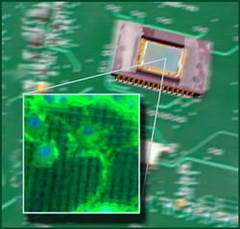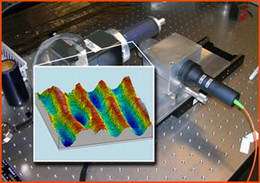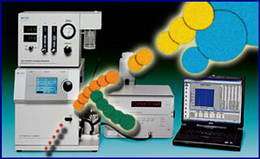Berkeley Lab Wins Three R&D 100 Awards: Neural Matrix CCD, Optical Sound Restoration System, Ion Mobility Analysis
Scientists at the Department of Energy's Lawrence Berkeley National Laboratory have garnered three R&D 100 Awards, R&D Magazine's picks for the 100 most technologically significant new products of 2005. This is the first time since 1992 that Berkeley Lab has captured three of the prestigious awards in a single year, bringing the Lab's total of these "Oscars of Invention" to 37.
The 2005 awards go to:
-- The Neural Matrix CCD, created by members of the Life Sciences, Accelerator and Fusion Research, and Engineering divisions, being further developed in tandem with co-award winners Cellular Bioengineering, Inc. (CBI) of Honolulu, Hawaii — the only state-of-the-art technology for patterning and monitoring networks of growing neurons;
-- The Optical Sound Restoration System, from the Physics Division — the first "touchless" technology for restoring early sound recordings on metal foil, wax, plastic, and other media, regardless of scratches, warping, mold, and other effects of age;
-- Ion Mobility Analysis, developed by members of the Life Sciences and Engineering divisions — providing fast, inexpensive, accurate measurement and counting of individual lipoprotein particles to assess the risk of coronary artery disease.
"These awards demonstrate that DOE scientists and researchers are hard at work developing the technologies of the future," said Secretary of Energy Samuel W. Bodman. "In the past, breakthroughs like these have played an important role in both our economic and national security."
"We're looking for products and processes that can change people's lives for the better, improve the standard of living for large numbers of people, save lives, promote good health, and clean up the environment," say the editors of R&D Magazine, which has handed out R&D 100 Awards annually since 1963.
"Two of this year's winning technologies have already been licensed by the Technology Transfer Department to companies that are working to bring them to market and benefit the public," says Pam Seidenman of Berkeley Lab's Technology Transfer Department, which aided the scientists in crafting the complex and demanding applications, "and the third may be deployed by the Library of Congress."
The Neural Matrix CCD

Initially designed to help scientists learn how neurons in the human nervous system communicate with each other, the Neural Matrix CCD is the first step in creating combined biological and electronic chip implants that can provide neural networks of living, interconnected nerve cells for testing drugs and sensing toxins for homeland security — and, someday, restoring the use of limbs and eyesight and improved mental functions in patients.
In 2004, a team of scientists and engineers led by Eleanor Blakely and Ian Brown, including Kathy Bjornstad, Jim Galvin, Othon Monteiro, and Chris Rosen, developed a technique for growing the first large arrays of networked neurons on the prepared optical surface of a charge-coupled device (CCD). Diamond-like carbon deposited on the optical surface of the CCD is patterned in fine detail, then coated by a continuous layer of cell-culture collagen, and finally seeded with neurons. The coated CCDs now have millions of individual sensors that can record changes in electrical potential from individual nerve cells in real time while precisely mapping each neuron's activity within the neural network.
Development of the Neural Matrix CCD is now under way in collaboration with Cellular Bioengineering Incorporated (CBI), a life sciences company focusing on the bioengineering of tissues for the replacement and repair of injured and diseased organs; CBI researchers Amy Weintraub, Ryan Littrell, Kevin T.C. Jim, Kevin Chinn, Leslie Isaki, and Geming Lui have contributed. Current research focuses on detection of neurotoxins and is funded by the Defense Advanced Research Projects Agency (DARPA).
The Optical Sound Restoration System

Since 1877, when Thomas Edison recorded "Mary had a Little Lamb" on a tinfoil cylinder, recordings on diverse media like foil and wax cylinders, shellac and vinyl discs, acetate sheets, and plastic dictation belts have captured an incredible range of material: the singing voice of Enrico Caruso; the poetry of Edna St. Vincent Millay; the lost language of Ishi, the last Yahi Indian; the words of historical figures like Alfred Lord Tennyson and Amelia Earhart. Many of these can no longer be played and are too delicate for traditional restoration.
By adapting methods for measuring particle tracks in high-energy physics experiments, Carl Haber and Victor Fadeyev created a noncontact method for restoring damaged and fragile mechanical recordings. Without ever touching the cylinder, disk, or belt, their technology produces two- or three-dimensional digital images of its surface, which can be computer analyzed to reconstruct the original recorded sound in high fidelity.
Archivists estimate that 40 percent of the millions of recordings in the world's major sound archives — including the U.S. Library of Congress, the British National Library, the New York Public Library, the Edison National Historical Site in New Jersey (with its trove of cylinders), and historical archives in major universities and private collections — could benefit from restoration with the Berkeley Lab technology.
Ion Mobility Analysis

For over fifty years, standard tests that measure levels of total cholesterol, "bad" low-density lipoproteins (LDL), "good" high-density lipoproteins (HDL), and triglycerides have been used to evaluate the risk of heart disease. But half the heart attacks in the U.S. each year strike people with normal cholesterol levels. The distribution of size, quantity, and type of lipoprotein particles — which are much more various than standard tests can account for — provides a far better indicator of whether or not someone is at risk.
Henry Benner, Ron Krauss, and Patricia Blanche developed ion mobility analysis to measure the size distribution and count the number of individual particles in all classes of lipoproteins in a single analytical step. The technology measures the drift of charged, aerosolized lipoproteins as they are dragged through air by the force of an electric field. Charge and drift velocity separate the particles by weight and size. The sorted particles travel to a detector for counting.
Ion mobility analysis is faster and potentially less expensive than current technologies and is likely to be used more frequently in the evaluation and management of risk for cardiovascular disease. Its ability to study the entire range of lipoprotein particles with unrivalled accuracy will make it a valuable tool for both clinical and research labs.
The R&D 100 Award-winning technologies were nominated by Berkeley Lab's Technology Transfer Department. All winners of the 2005 award will receive a plaque at R&D Magazine's formal awards banquet in Chicago on October 20.
Source: Berkeley Lab

















